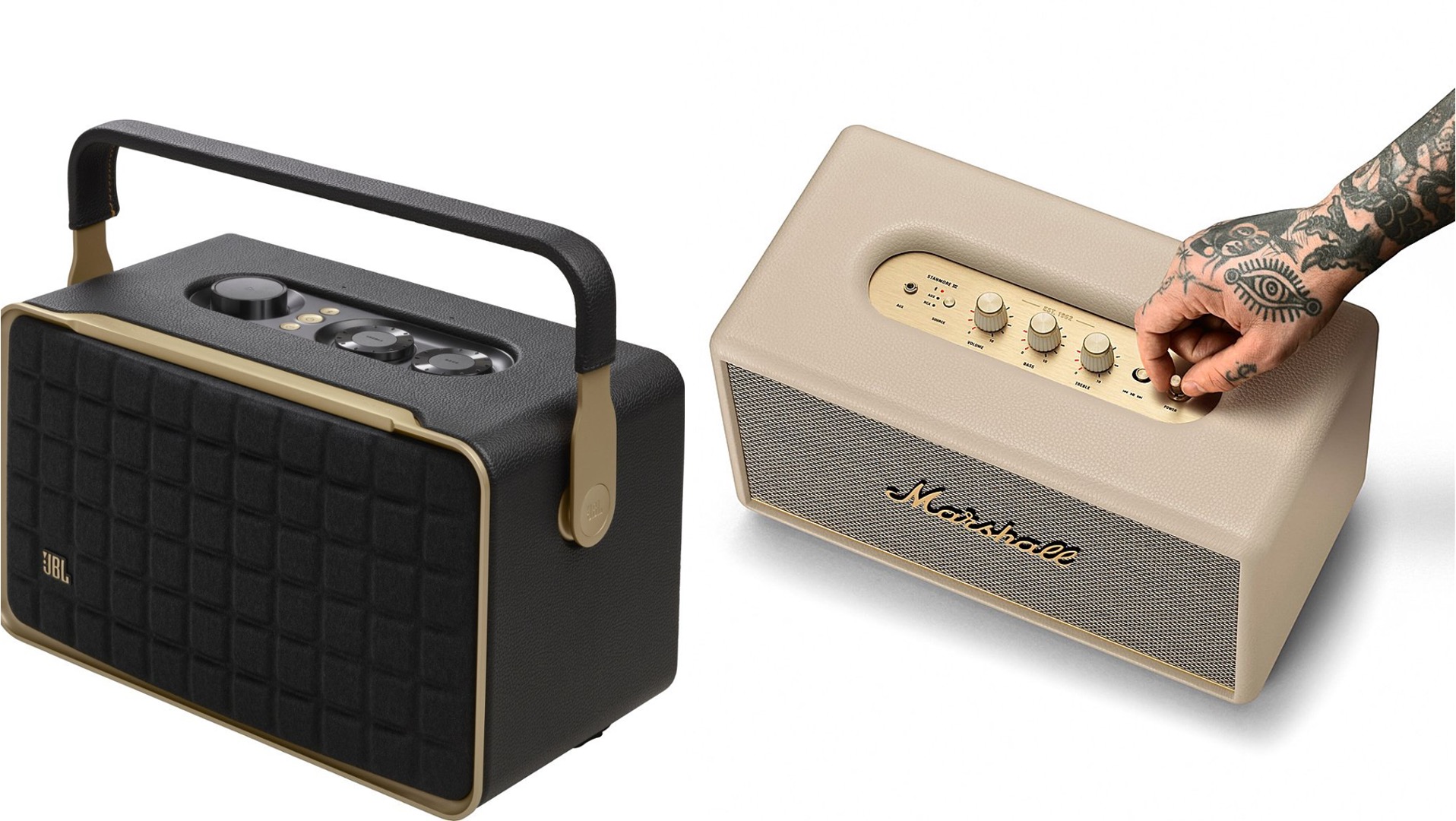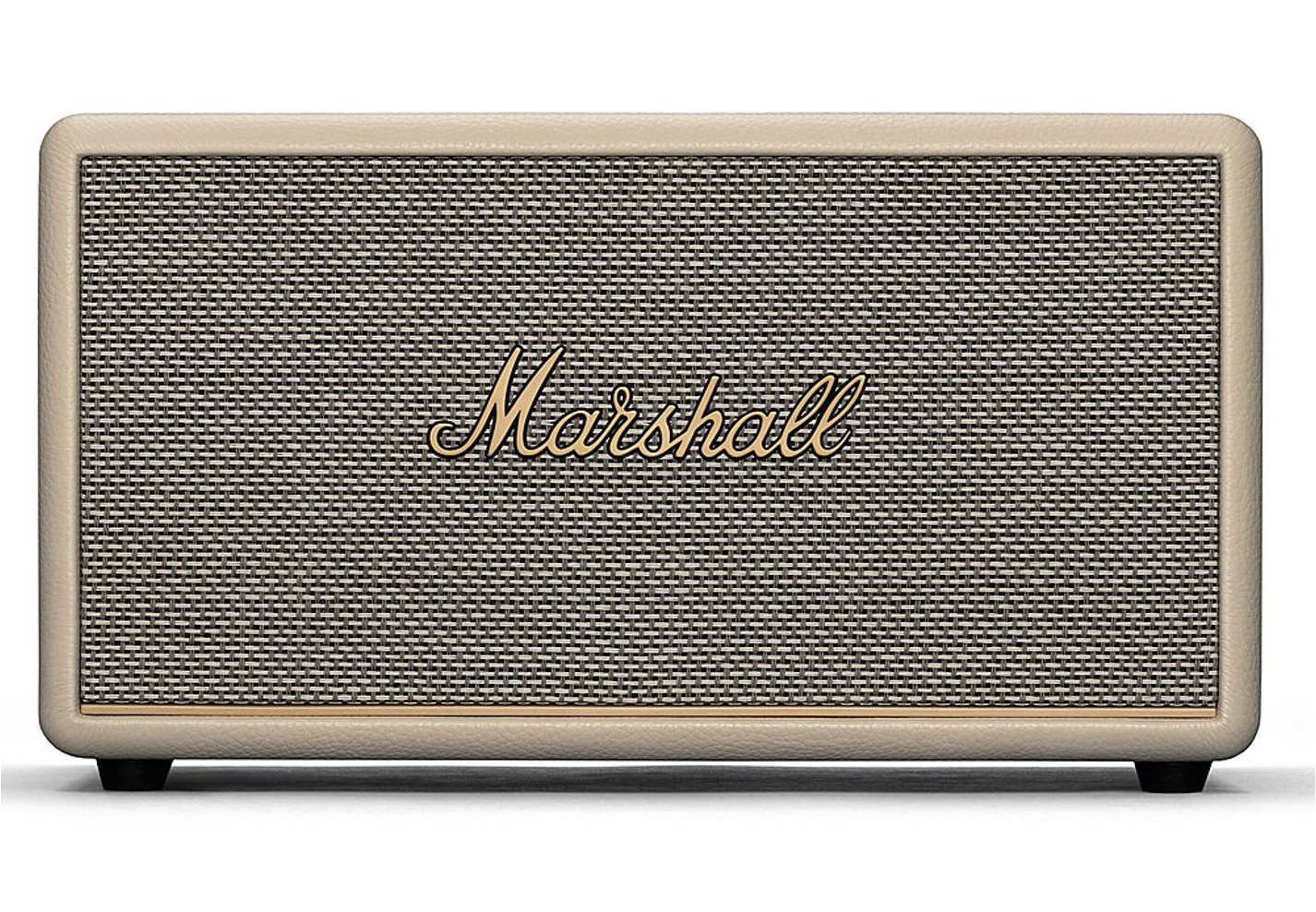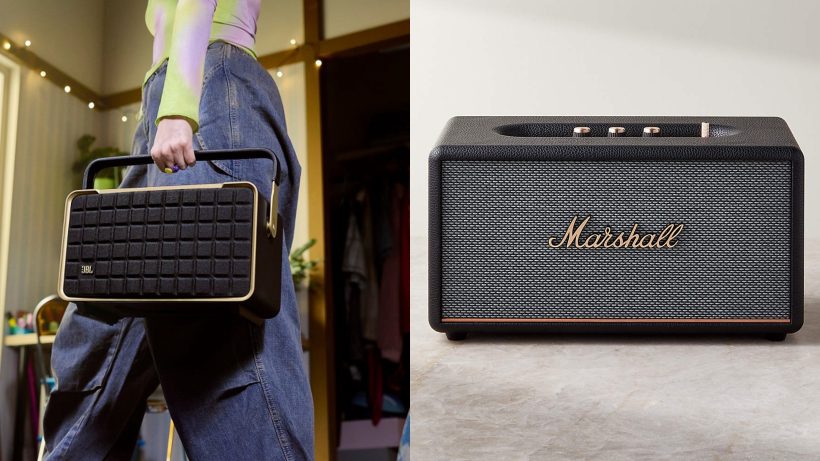The JBL Authentics 300 is essentially a mid-tier speaker between the JBL Authentics 200 and the Authentics 500, and is often compared to the Marshall Stanmore III when it comes to sound performance and specs. First up, we need to state that the JBL Authentics 300 is designed to be louder and more powerful than the Stanmore III with a total power output of 100W (compared to the Stanmore 3’s total 80W output), and it comes with several improved features such as a pair of 25mm tweeters and a full-range 5.25 inch woofer that delivers really nice highs and midranges. The Authentics 300 also comes with a down-firing 6.5 inch passive bass radiator which helps to enhance the low-end bass range. It’s a speaker that’s capable of delivering really loud sound performance with a lot of bass if you turn up the bass on the speaker.
The Marshall Stanmore 3, by contrast, is delivers crisper and brighter highs with up to 80W of total output power (it sounds much better for vocals and live jazz music). It comes with two 15W class D amps for the tweeters and a single 50W amp for the woofer, delivering solid bass and crystal clear highs. Comparatively, it is a really similar speaker to the Authentics 300 in terms of specs, except for the fact that the Authentics 300 also comes with a built-in battery that delivers up to 8 hours of playtime on a single charge when not connected to AC power (the Stanmore 3 does not come with a built-in battery). Personally, I found that the Authentics 300’s battery is not really necessary as this is not the kind of speaker that you would take with you for portable listening – it’s essentially built as a wireless home speaker to be stationed in a living room or large space and it is a massive 100W of output power compared to the Stanmore 3’s 80W.
If you are interested in how the highest tier JBL Authentics 500 competes with the Marshall Woburn 3, be sure to check out our in-depth JBL Authentics 500 vs Marshall Woburn 3 Review here.
Let’s compare the specs of the JBL Authentics 300 vs the Marshall Stanmore 3:
JBL Authentics 300 vs Marshall Stanmore 3 Specs
| Feature | JBL Authentics 300 | Marshall Stanmore 3 |
| Wattage | 100W | 80W |
| Power Supply | 100 – 240V AC, ~ 50/60Hz | 100-240 V |
| Total Speaker Power Output | 100W (Max @THD 1%) | 80W (50W Class D amplifier for the woofer + Two 15W Class D amplifiers for the tweeters) |
| Transducer | 2 x 25mm tweeter + 5.25″ woofer | – |
| Frequency Response | 45Hz – 20kHz (-6dB) | 45 – 20,000 Hz |
| Bluetooth Version | 5.3 | 5.2 |
| Wi-Fi Network | IEEE 802.11 a/b/g/n/ac/ax (2.4GHz/5GHz) | No |
| Battery | 3.6V, 4800mAh, up to 8 hours playtime | No built-in battery, requires power supply from mains |
| Weight | 4.9 Kg / 10.8 lbs | 4.25 kg / 9.37 lb |
| Dimensions (W x H x D) | 342 x 195.6 x 180.3 mm / 13.46″ x 7.7″ x 7.1″ | 350 x 203 x 188 mm / 13.78 x 8.00 x 7.40 in |
| Connectivity | Bluetooth/WIFI, Ethernet, USB, 3.5 mm audio cable Input | 3.5 mm Input, RCA Input, Bluetooth 5.2 |
| Voice Assistant Integration | Yes, Google Assistant and Amazon Alexa simultaneously | No |
| Additional Features | Music streaming services via built-in Wi-Fi, Multi-room playback, Automatic tuning | Adjustable Bass and Treble Controls through analogue controls or Marshall Bluetooth App, Room compensation via app |
The JBL Authentics 300 offers a wide range of connectivity options, including Wi-Fi, Ethernet, and USB, along with Bluetooth 5.3, making it versatile for various streaming services and capable of multi-room playback. It also supports voice assistant integration with both Google Assistant and Amazon Alexa, providing hands-free control. The built-in battery supports up to 8 hours of playtime which makes it a uniquely portable wireless home speaker compared to the Marshall Stanmore 3.
Sound Performance
We played a couple of music soundtracks including Ed Sheeran’s “Shape of You” and Tony Bennett’s “Fly me to the moon” on both speakers to test out how they handle vocals and higher pitched sounds. Straight off the bat, the Marshall Stanmore III sounded much brighter than the Authentics 300 and sounds better for vocals and higher pitched sounds (especially instrumental notes such as cymbals and guitars). These sounds come across as more refined with better timbre on the Stanmore III than the Authentics 300, and the Stanmore III has a little hint of vintage warmth which makes vocals and jazz performances sound brighter and more interesting to listen to.
By contrast, the JBL Authentics 300 sounded a little more balanced and has slightly warmer and deeper bass (that feels much more present and emphasized) as compared to the Stanmore III. That being said, the Authentics 300 does not have the crispness in the highs and the brightness in the vocals that the Marshall speaker has. The Authentics 300 is clearly geared towards those who want a more bassy sound signature, as Ed Sheeran’s “Shape of You” sounded really punchy with nice bass beats that feel tight and has plenty of depth.
Needless to say, we enjoyed live jazz performances more on the Stanmore III. Tony Bennett’s “Fly me to the moon” sounded really crisp with plenty of sparkle in the high frequency ranges, and Dusty Springfield’s “The Look of Love” sounded spectacular with plenty of depth and gusto in the vocals – the Stanmore III adds a touch of vintage warmth and clarity to the vocals which I find much more entertaining to listen to rather than the Authentics 300’s balanced sound signature.
If you listen to a lot of live jazz and vocals at home, I would definitely recommend going with the Marshall Stanmore III rather than the Authentics 300. While the Authentics 300 definitely has much more powerful bass and a solid low-end punch, the way the speaker handles the highs and vocals sounds too “generic” and boring. The Stanmore III has more personality and can make vocals and timbre ranges sound very engaging, which is definitely what you would be looking for if you want to get a speaker for brighter vocals and crisper highs. The Stanmore III also delivers decent soundstage and separation which is comparable to the Authentics 300 (although you won’t be expecting much separation considering the size of both speakers).
The JBL Authentics 300 sounds better for EDM and rock music performances with a deeper low-end punch. The Authentics 300 is also a slightly more powerful speaker and is a great option if you need a speaker for blasting loud music at parties or events. That being said, I preferred the Marshall Stanmore III’s sound signature as it can make your music sound much more engaging and lifelike especially for live jazz performances, while the JBL Authentics 300 is more focused on delivering a balanced sound signature.

Specs and Design
In terms of design, the JBL Authentics 300 features a retro design that comes with a cast-aluminium handle, custom leather enclosure and a Quadrex grille which gives it a vintage appearance. The speaker also comes with a passive bass radiator located at the back of the speaker which enhances the low-end sound performance.
Having said that, the Marshall Stanmore III looks much classier and vintage with its brass plated front and top control panel. While the volume knobs on the JBL Authentics 300 look like they are made from plastic, the Stanmore III’s knobs are brass plated and feel really nice to touch and play around with. Both speakers come with a custom leather-like enclosure which gives it a solid and vintage appearance, although I would say that the Stanmore III just looks like a more classy vintage speaker through and through, while the Authentics 300 just looks more “plastic”.

One thing to consider when choosing between both speakers is that the JBL Authentics 300 comes with slightly more updated features such as the latest Bluetooth 5.3 and Wi-Fi. This feature is particularly useful if you want to stream music through AirPlay, Alexa Multi-Room Music or using Spotify Connect – these features are only available on the Authentics 300 as the Stanmore III does not support them.
The JBL Authentics 300 also comes equipped with a 4800mAh battery which provides between 6-8 hours of playtime if you use the speaker at 50% volume level, which is pretty decent but a rather unnecessary feature as the Authentics 300 is meant to be a wireless home speaker to be connected to an AC power outlet (it’s definitely not the kind of portable speaker that you would take around with you). The Authentics 300 also comes with a handle for portability but I did find that the handle affects the overall aesthetics of the speaker – it just doesn’t feel as vintage and retro as the Marshall Stanmore III, and is designed as a hybrid between a portable and a home speaker. Personally I didn’t like this as it feel as though the JBL Authentics 300 is trying to do too many things, and it does not provide the same level of classy aesthetics that the Marshall Stanmore III provides.
The Verdict?
If I had to choose between the JBL Authentics 300 and the Marshall Stanmore III, I would prefer the Stanmore III for its crisper highs and better overall sound performance and design. Not only does the Marshall Stanmore III outperform the Authentics 300 in terms of sound performance and in the highs, it also has a much more classy vintage appearance as compared to the Authentics 300 such as brass plated control knobs which are in stark contrast the Authentic’s 300 plastic knobs. The Authentics 300 also comes with a built-in battery and carrying handle which I felt to be rather unnecessary as this is not the kind of speaker that you would take around with you outdoors – it is designed for comfortable home listening. The Stanmore III just exudes a much more classy and well-designed aesthetic than the Authentics 300 speaker. While the JBL Authentics 300 does deliver slightly louder sound performance with a 100W output power compared to the Stanmore 3’s 80W, and has slightly deeper bass performances, we felt that the Stanmore III just sounded much more classy and in-line with what a retro vintage speaker should sound, especially with a good emphasis on the highs with really good depth.
If you are choosing between the JBL Authentics 300 vs the Marshall Stanmore III, I would highly recommend going with the Marshall Stanmore III speaker for its classy design and really nice highs and timbre ranges which outshines the advantages that you get with the Authentics 300.
Read more: JBL Authentics 500 Review: Old School but Big Sound

